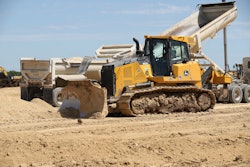
In the two years since the federal $1.2 trillion infrastructure law was signed by President Joe Biden, $400 billion has been earmarked for more than 40,000 projects, according to the White House.
That funding has also “helped drive over $614 billion in private sector manufacturing and clean energy investments,” the Biden administration says.
Among the infrastructure funding results has been starting improvements on 135,800 miles of roads and launching over 7,800 bridge repair projects, according to the administration.
Funding has also been announced for the following, according to the White House:
- Deploy over 2,900 low-and zero-emission American-made transit buses and 2,400 clean school buses;
- Delivered funding for 445 port and waterway projects to strengthen supply chains, speed up the movement of goods, lower costs and reduce greenhouse gas emissions;
- Deployed investments in over 190 airport terminal projects to modernize and expand terminals – 18 of which are under construction and 8 more that are complete;
- Launched seven Regional Clean Hydrogen Hubs with $50 billion in public and private sector investment;
- Launched over 2,300 projects to help communities build resilience to threats such as the impacts of climate change and cyber-attacks;
- Financed over 1,200 drinking water and wastewater projects across the country, including projects that will replace hundreds of thousands of lead service lines;
- Removed hazardous fuel material from 8.7 million acres to protect communities from wildfires;
- Funded nearly 400 projects for water recycling, storage, conservation, desalination and other purposes to improve drought resilience across the West;
- Provided funding to over 100 states, tribes and territories and launched over 60 projects to improve the resilience and reliability of America’s electric grid and deliver cheaper and cleaner electricity;
- Plugged over 6,000 orphaned oil and gas wells to address legacy pollution;
- Awarded funding to 70 previously unfunded Superfund projects.
Transportation Funding
When focusing on transportation funding since the infrastructure law was signed in 2021, the American Road and Transportation Builders Association announces the following highlights:
- Nearly $100 billion in new project commitments.
- 168 projects receiving over $100 million in federal support.
- 96 percent of counties have at least one project.
- State departments of transportation are increasing capital spending by 13 percent.
- Nearly $8 billion in road and bridge-related discretionary grant improvements announced by USDOT.
- The value of state and local highway and bridge contracts awards was up a record 26 percent in 2022.
- In 2023, the value of awards is up in 35 states compared to 2022, increasing a total of 12 percent.
- Average highway construction employment in 2023 is up 8 percent.
- 24 percent of funds spent on new construction or added capacity.
Boosting Construction Employment
 White House
White House
“Employment in the construction sector has exceeded the pre-Great Recession high for the first time, with last month setting a new record high going back to the start of the data in 1939,” the Biden administration reports.
Since Biden took office the heavy and civil engineering sector has added 92,400 jobs. Of that number, highway, street, and bridge construction accounted for 38,300 of those jobs, surpassing its pre-Great Recession high.
Building construction sectors, which includes residential and nonresidential, has added 187,000 jobs since Biden took office.
 White House
White House
State-by-State Breakdown
For details on how much your state is getting from the infrastructure law and where it’s being spent, check out these resources:
The White House has released updated state by state fact sheets, along with an updated map showcasing the more than 40,000 projects and awards identified or now underway.
ARTBA has set up a dashboard in which you can click on individual states on a map for a closeup look at how infrastructure law money has been invested so far on highway and bridge projects.










